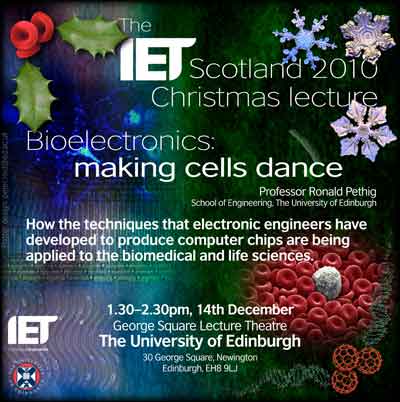Case study #4
Bioelectronics: the IET Christmas Lecture
 In mid-2010, FUSION was approached by Professor Ron Pethig (chair in Bioelectronics at the Integrated Micro and Nano Systems Research Institute, in the School of Engineering) to help design and present the IET Christmas lecture.
In mid-2010, FUSION was approached by Professor Ron Pethig (chair in Bioelectronics at the Integrated Micro and Nano Systems Research Institute, in the School of Engineering) to help design and present the IET Christmas lecture.
The lecture was to be delivered to a group of Scottish secondary schools, in November and December of 2010. (Weather conditions intervened, and some of the lectures eventually had to be postponed to the following year.) Ron approached our team specifically to provide assistance in the area of school (and general public) engagement.
The science of Bioelectronics is not a familiar subject for the public at large, and the talk had to lay considerable groundwork in the underlying sciences, before we could explore some of the more complex areas of research.
Bioelectronics is concerned with the manipulation of cell structures using complex electric fields, shaped by tiny clusters of electrodes. One problem immediately became clear: how to give the audience a sense of the scale of these electrodes, and indeed in the length-scales of individual cells. Some time was spent designing 3D graphic animations (shown below), to bring this home to the audience (as quickly as possible, given the amount of material to be covered in the talk.)
The talk leant heavily on film clips, edited and arranged to seamlessly move from one to the other, with a minimum of text. Humour (as befits a Christmas show) was added throughout, and the show was kept lively.